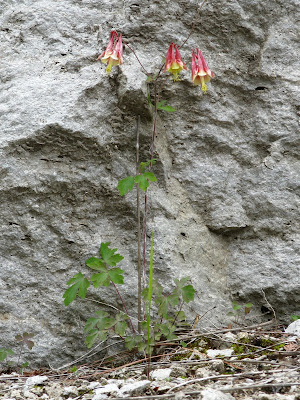Such was the case a few weeks back, when I saw a beautiful stand of Aquilegia canadensis, the Canadian Columbine, on wooded and rocky outcrops along Twiss Road, just north of Burlington, Ontario.
 The self-sowing tendencies of this plant were evident with several plants established on various levels of the outcrop, as well as in an actual row alongside the road. In my garden, I let it do its thing amongst Hostas, ferns and Martagon Lilies.
The self-sowing tendencies of this plant were evident with several plants established on various levels of the outcrop, as well as in an actual row alongside the road. In my garden, I let it do its thing amongst Hostas, ferns and Martagon Lilies.I've long been enamoured by this plant, preferring its grace and subtle beauty over the larger-flowered modern hybrids. Phillips and Rix state that it is pollinated by hummingbirds.
 More recently, the dwarf strain 'Little Lanterns' has been very impressive, as well as the newer 'Pink Lanterns'.
More recently, the dwarf strain 'Little Lanterns' has been very impressive, as well as the newer 'Pink Lanterns'. Interestingly, Jelitto and Schacht record several forms of the species: "albiflora with white flowers, flaviflora flowers entirely yellow, and phippenii sepals pink, petals yellow" which must have been used to create the newer seed strains.
Interestingly, Jelitto and Schacht record several forms of the species: "albiflora with white flowers, flaviflora flowers entirely yellow, and phippenii sepals pink, petals yellow" which must have been used to create the newer seed strains.Here's to dirt under your nails.
Mark, the coolplantsguy






2 comments:
Mark- I was reading through the native forum on GW and saw your blog link. I'm interested in the native Columbines, but I think A. formosa is the one native to my area in the pnw. It's very similar, I'm not able to distinguish which I would like better. I have a blog too, I'm interested in native plants but not exclusively.
Hi Hannah - thanks for visiting. I didn't realize these two species were so similar. In any case, I'll check out your blog.
Post a Comment